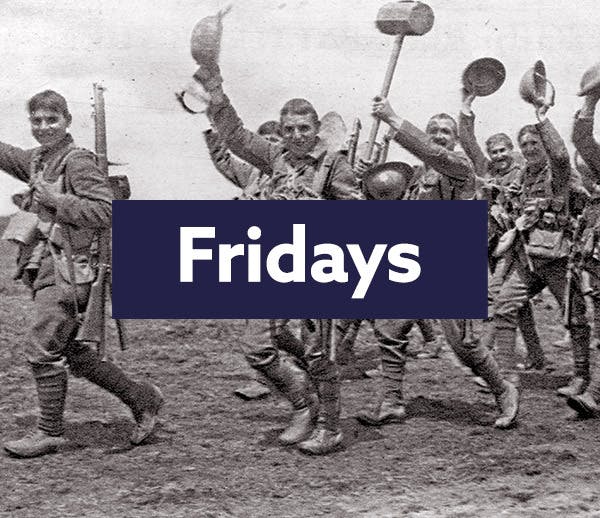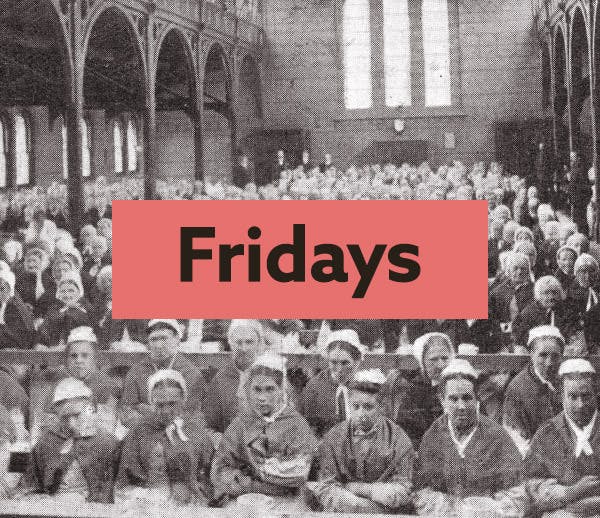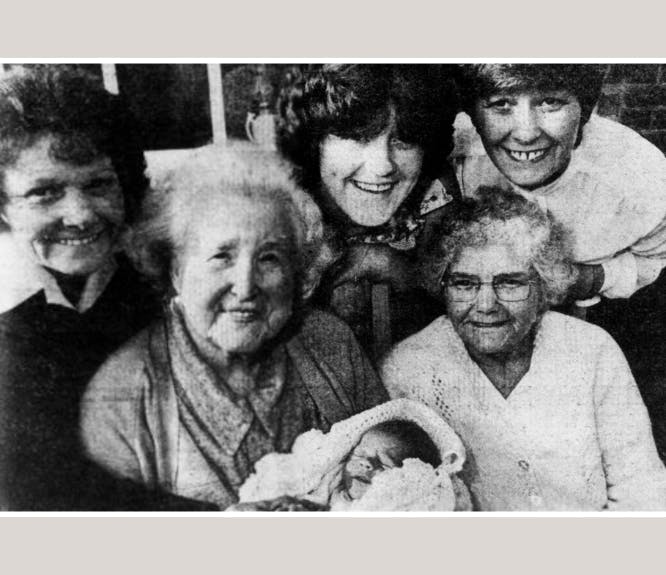The definitive guide to the Titanic's passenger lists
7-8 minute read
By The Findmypast Team | September 13, 2020
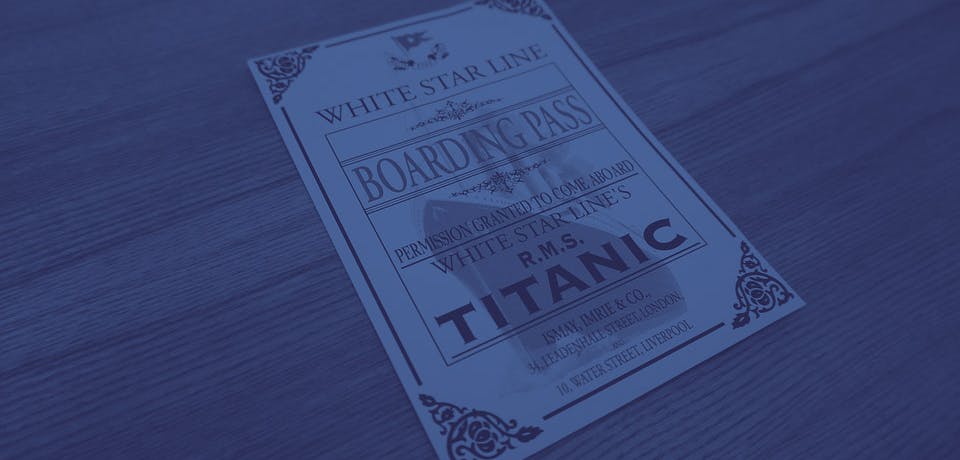
We've picked apart the Titanic's passenger lists to reveal the stories behind the names, dates, strikethroughs and check marks.
Records for the Titanic are held in the BT 27 passenger list collection at The National Archives in Kew, England. They were digitized in color and can be found in Findmypast’s Passenger Lists Leaving UK 1890-1960.
The Titanic's passenger list is in two parts. One part is for passengers who boarded at Southampton, England on April 10, 1912. The other part is for passengers who boarded at Queenstown (now Cobh), Cork, Ireland a day later. Passengers who boarded at Cherbourg, France on April 10 before the ship's onward journey to Queenstown are not included in BT 27.
As precious historical documents, both surviving Titanic passenger lists are kept under lock-and-key in The National Archive’s strong room. The Southampton list has been conserved by The Archive's in-house conservators using Japanese tissue and is bound into hard covers. The Queenstown list is still in its original format.
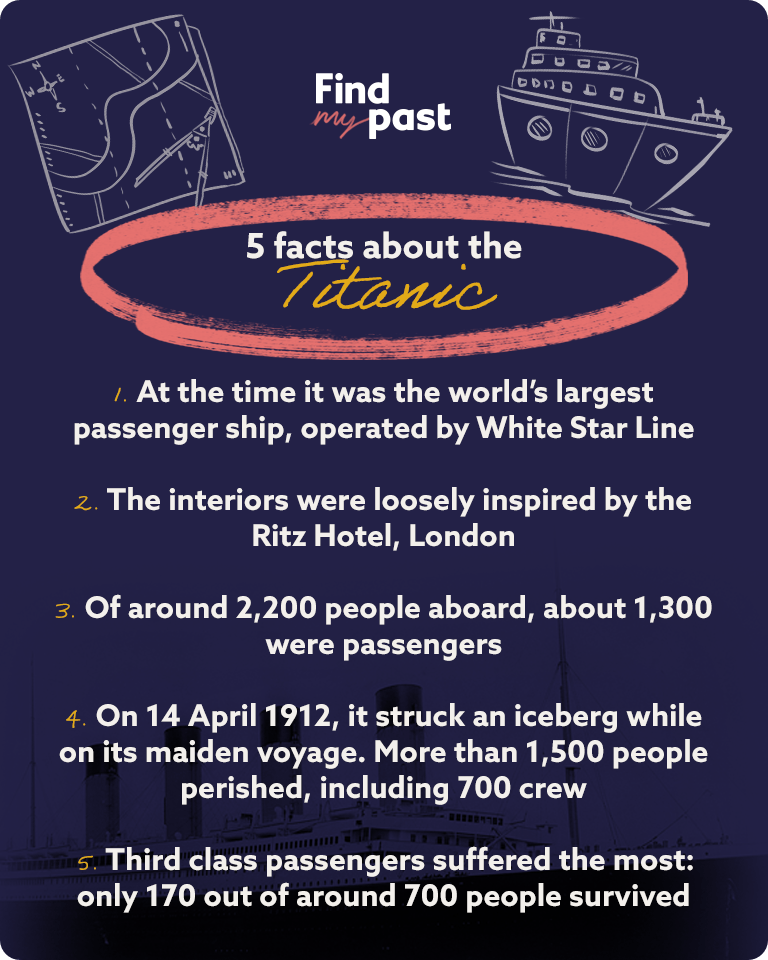
Other than Captain Edward John Smith, the passenger lists give no information about any other crew on board the Titanic. The purpose of passenger lists was, as the name indicates, to record passengers and not the crew. The manifests which the shipping company was required to return to the Board of Trade for official purposes usually record only the master and his passengers.
The Titanic's Southampton passenger list
The passenger list taken at Southampton comprises the following 30 pages. On the top right of each page (with the exception of the folder cover) is a neat foliation number corresponding to the page numbers below.
- The folder in which the list itself is kept in The National Archives' strong room.
- Inside cover of the folder, showing dates of repair to the passenger list.
- Note about the existence of two passenger lists and the lack of a Cherbourg boarding list.
- Header page, with details of the vessel (White Star Line’s Titanic, official number 131428) and master (and signed by him as Edwd J Smith). 3rd class British passengers – 29 in total. Occupations and ages are given.
- 3rd class British passengers – 44 in total. Occupations and ages are given.
- 3rd class British passengers – 45 in total. Occupations and ages are given.
- 3rd class British passengers – 12 in total. Occupations and ages are given.
- 1st class British passengers – 46 in total.
- 1st class British passengers – 8 in total.
- 1st class British passengers – 5 in total, traveling to Queenstown and Cherbourg only.
- 2nd class British passengers – 47 in total. Ages are given.
- 2nd class British passengers – 46 in total. Ages are given.
- 2nd class British passengers – 46 in total. Ages are given.
- 2nd class British passengers – 41 in total. Ages are given.
- 1st class Alien Non-Transmigrants from Austria – 2 in total, traveling to Cherbourg only.
- 1st class Alien Non-Transmigrants from Germany, Sweden, and USA – 46 in total.
- 1st class Alien Non-Transmigrants from Germany and USA – 45 in total.
- 1st class Alien Non-Transmigrants from USA – 35 in total.
- 2nd class Alien Transmigrants from Denmark, Finland, Norway, Sweden, and USA – 20 in total. Ages and means of arrival in the UK given.
- 2nd class Alien Non-Transmigrants from Austria, France, Germany, Hungary, Japan, Portugal, Russia, Spain, Sweden, and USA – 47 in total. Ages are given.
- 3rd class Alien Non-Transmigrants from Denmark, Germany, Italy, Russia, Sweden, Turkey, and USA – 46 in total. Occupations and ages are given.
- 3rd class Alien Non-Transmigrants from China – 8 in total. Occupations and ages are given.
- 3rd class Alien Transmigrants from Denmark, Finland, France, Norway, Sweden, and USA – 46 in total. Ages and means of arrival in the UK given.
- 3rd class Alien Transmigrants from Austria, Belgium, Norway, Switzerland, and USA – 44 in total. Ages and means of arrival in the UK given.
- 3rd class Alien Transmigrants from Belgium and Sweden – 44 in total. Ages and means of arrival in the UK given.
- 3rd class Alien Transmigrants from Bulgaria, Norway, and Sweden – 45 in total. Ages and means of arrival in the UK given.
- 3rd class Alien Transmigrants from Austria, Bulgaria, Sweden, Switzerland, and Turkey – 45 in total. Ages and means of arrival in the UK given.
- 3rd class Alien Transmigrants from Denmark, Finland, Sweden, and Russia – 45 in total. Ages and means of arrival in the UK given.
- 3rd class Alien Transmigrants from Finland, Italy, Portugal, and Syria – 42 in total. Ages and means of arrival in the UK given.
- Summary sheet.
The word “disregard” is penciled on pages 10 and 15 in relation to the short-haul passengers traveling to Queenstown and Cherbourg. These passengers were never bound for New York.
The Countries listed are those of which the passenger was a citizen or subject. So, keep the political geography of 1912 in mind. For example, Austria signifies the Austrian Empire and many of the Austrians appear to have been Croats. Similarly, many of the stated Russians were Jews rather than ethnic Russians.
Interesting finds
Two names on the Southampton passenger lists have been struck through and annotated with an 'x' on page 14. This would normally indicate that they purchased tickets but did not travel.

However, in this case, they have been crossed off merely because of duplication. They also appear on page 20, where they have not been struck out and they have a tick against their names. They both boarded the Titanic.
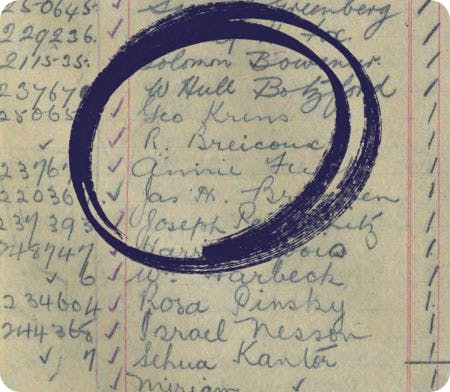
Similarly, on page 19, Alice T Teroan's name has been struck through and annotated with an 'x'.

However, it's understood she was listed like this because she did not board at Southampton but later the same day at Cherbourg.
Emma Duyvejonck (ticket 345766 on page 24) and Henri Van Der Steen (ticket 345782 on page 25) have been struck through, do not have ticks before their names, and are marked “Rej” (rejected on medical grounds).
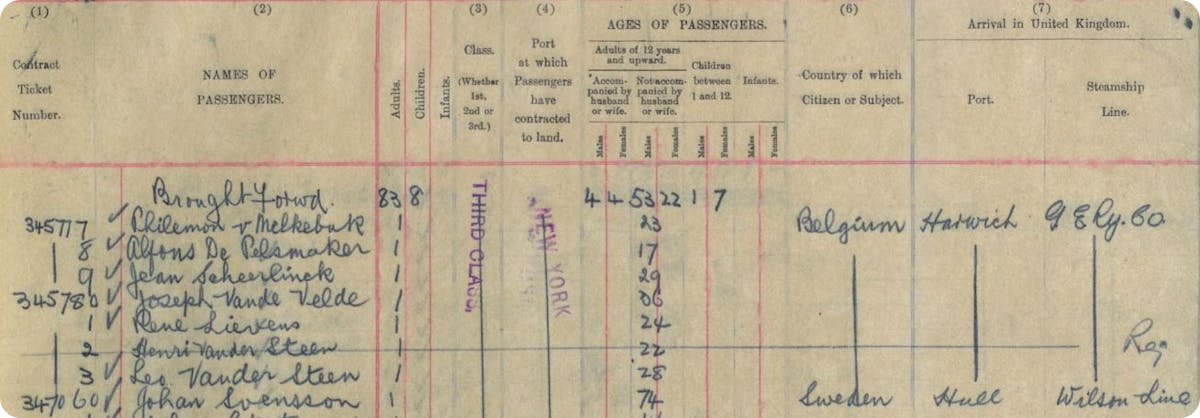
Again, this indicated that they purchased tickets but did not travel.
While Elias Johannessen (ticket 312988 on page 23) has not been struck through but does not have a tick before his name. He purchased a ticket but did not to travel due to illness:
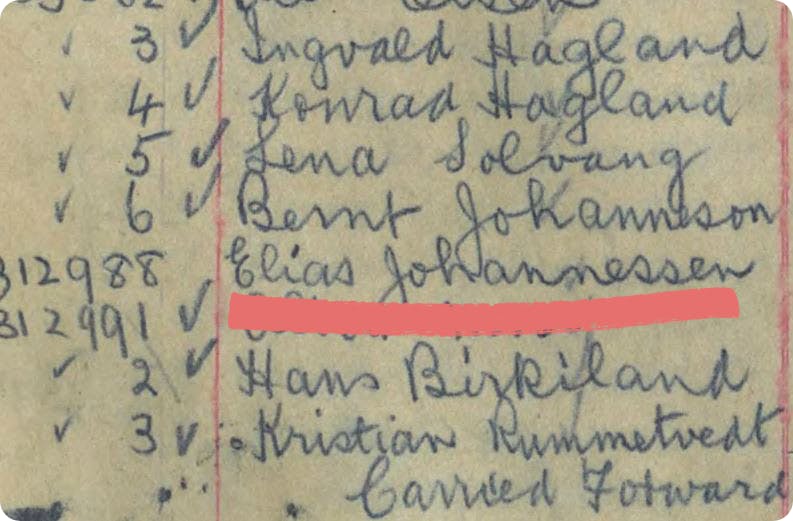
The Southampton list is in six different hands, meaning six clerks recorded it. How they took the information and what they included differs as follows:
- Hand A: compiled pages 4-7 (3rd class British passengers). He used a rubber stamp for class and destination port and recorded occupations and ages. He also compiled page 30.
- Hand B: compiled pages 8-10 and 15-18 (1st class British and Alien passengers). He did not use a rubber stamp and did not record occupations or ages. He is the only clerk to record passengers’ surnames before their forenames.
- Hand C: compiled pages 11-14 and 19-20 (2nd class British and Alien passengers). He did not use a rubber stamp, did not record occupations but did record ages.
- Hand D: compiled pages 21-22 (3rd class Alien Non-Transmigrants). He used a rubber stamp for class and destination port and recorded occupations and ages.
- Hand E: compiled pages 23-25, 27, and the lower half of 29 (3rd class Alien Transmigrants). He used a rubber stamp for class and destination port, did not record occupations but did record ages.
- Hand F: compiled pages 26, 28, and the upper half of 29 (3rd class Alien Transmigrants). He also appears to have entered the last three names on page 7. He used a rubber stamp for class and destination port, did not record occupations but did record ages. The penmanship of Hand F is poor and his spelling is suspect. This problem was exacerbated by what would have been, for him, the presumably difficult and unfamiliar Bulgarian and Scandinavian names he had to record. Many of these names were wrongly copied down by Hand F and are spelled incorrectly in the list.
The Titanic's Queenstown passenger list
The Queenstown passenger list is made up of 7 pages:
- Header page with details of the vessel and master (again signed by him) and listing 3rd class British passengers - 29 in total. Occupations and ages are given.
- 3rd class British passengers – 35 in total. Occupations and ages are given.
- 3rd class British passengers – 39 in total. Occupations and ages are given.
- 3rd and 2nd class British passengers – 13 in total. Occupations and ages are given.
- 3rd and 2nd class Alien Non-Transmigrants from USA – 11 in total. Occupations and ages are given.
- Recapitulation sheet.
- Summary sheet.
Notable discoveries
No 1st class passengers boarded at Queenstown. All of the passengers listed as British were Irish. At the time, the entire island of Ireland was part of Britain, and its people were regarded as British. All of the Alien passengers were Americans.
Frank Dwan (ticket 336439 on page 3) and Patrick Fox (ticket 368573 on page 5) have been struck through and do not have ticks before their names. As mentioned, this would normally indicate that they purchased tickets but did not travel.
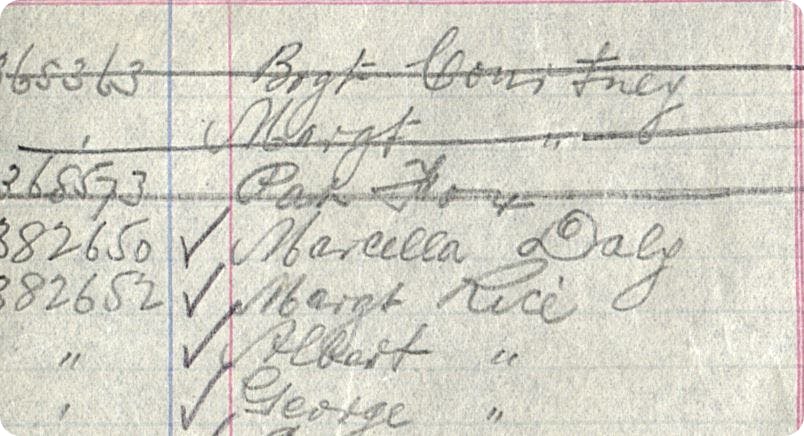
However, just as we saw with the Southampton passenger list, they have been struck through on these pages because of duplication. Frank Dwan also appears on page 2 and Patrick Fox also appears on page 4, where they have not been struck out. They both boarded the Titanic.
12 Queenstown passengers have been struck through and do not have a tick before their names, indicating that they purchased tickets but did not travel:
- Mary Jordan, traveling on ticket 30944 on page 1
- Margaret Gilligan, ticket 43131 on page 2
- James Tynan, ticket 38850 on page 2
- Norah Callaghan, ticket 364853 on page 2
- Annie Jordan, ticket 364854 on page 2
- Michael F O’Sullivan, ticket 366715 on page 3
- Mary Dunne, ticket 366984 on page 3
- Mary Martin, ticket 367167 on page 3
- John Concannon, ticket 382644 on page 3
- Delia Forkan, ticket 386588 on page 3
- Bridget Courtney, ticket 368363 on page 5
- Margaret Courtney, ticket 368363 on page 5
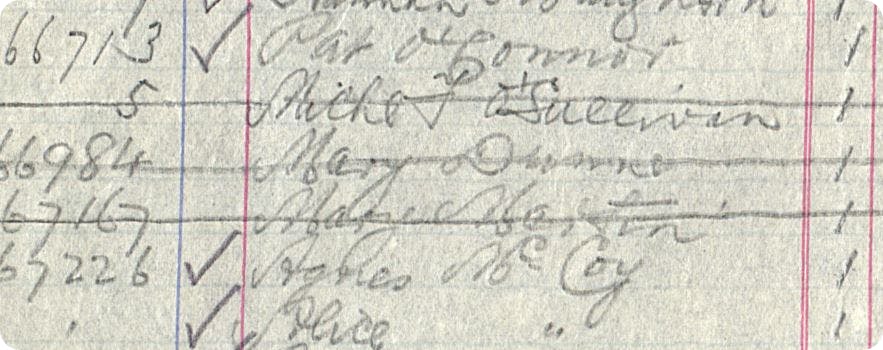
The Queenstown list is in two hands:
- Hand G: compiled pages 1-3 and the upper halves of pages 4 and 5 (3rd class passengers).
- Hand H: compiled the lower halves of pages 4 and 5 (2nd class passengers).
What else is revealed in the Titanic's passenger lists?
As well as anomalies regarding individual passengers, the spellings or mis-spelling of their names, and various inaccuracies relating to their ages, there are some other interesting finds.
It's not clear when the various annotations to the lists (strikethroughs, ticks, and crosses against names) were made. At least some of them were probably made back in port at the shipping line’s offices, or even at the Board of Trade offices, after the ship had set sail, rather than before or while the passengers boarded. The Titanic embarked from Southampton on April 10, 1912, but the Southampton list is rubber-stamped on page 30 with the date 9 April, indicating (unless the date stamp had not been rolled forward from the previous day) that the usual Customs House paperwork for the voyage had been completed the day before.
On the other hand, the Queenstown list is dated April 13, 1912, on page 1, which is two days after the Titanic set sail for New York. The rubber stamp is that of the Board of Trade Surveyors’ Office, not the Customs House.
Olympic and Liverpool were originally written on the header of page 6 of the Queenstown list (the recapitulation). These are crossed out and replaced with Titanic and Queenstown.

At least one passenger – the Rev Charles Leonard Kirkland – appears on both lists. He's on page 13 of the Southampton list and page 4 of the Queenstown list. He's thought to have sailed from Queenstown.


As mentioned, the word “disregard” is penciled on pages 10 and 15 of the Southampton list in relation to the short-haul passengers traveling to Queenstown and Cherbourg. In normal circumstances, “Disregard” was used to highlight passengers not to be included when counting long-haul passengers from the UK. However, for the Titanic, these notes were probably made when trying to determine who was on board the vessel when it sank. Passengers who disembarked at Queenstown and Cherbourg could clearly be excluded.
Does your family story overlap with the famous tale of the Titanic and its ill-fated maiden voyage? Were your relatives on board? We'd love to hear about your discoveries. Reach out to us on Facebook, Instagram, or Twitter to share your stories.

